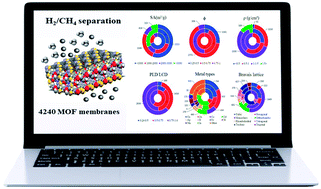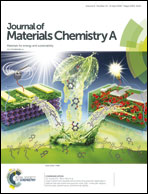Computer simulations of 4240 MOF membranes for H2/CH4 separations: insights into structure–performance relations†
Abstract
Design of new membranes having high H2/CH4 selectivity and high H2 permeability is strongly desired to reduce the energy demand for H2 production. Metal organic frameworks (MOFs) offer a great promise for membrane-based gas separations due to their tunable physical and chemical properties. We performed a high-throughput computational screening study to examine membrane-based H2/CH4 separation potentials of 4240 MOFs. Grand canonical Monte Carlo (GCMC) and molecular dynamics (MD) simulations were used to compute adsorption and diffusion of H2 and CH4 in MOFs. Simulation results were then used to predict adsorption selectivity, diffusion selectivity, gas permeability and membrane selectivity of MOFs. A large number of MOF membranes was found to outperform traditional polymer and zeolite membranes by exceeding the Robeson's upper bound for selective separation of H2 from CH4. Structure–performance analysis was carried out to understand the relations between MOF membranes' selectivities and their pore sizes, surface areas, porosities, densities, lattice systems, and metal types. Results showed that MOFs with pore limiting diameters between 3.8 and 6 Å, the largest cavity diameters between 6 and 12 Å, surface areas less than 1000 m2 g−1, porosities between 0.5 and 0.75, and densities between 1 and 1.5 g cm−3 are the most promising membranes leading to H2 selectivities >10 and H2 permeabilities >104 Barrer. Our results suggest that monoclinic MOFs having copper metals are the best membrane candidates for H2/CH4 separations. This study represents the first high-throughput computational screening of the most recent MOF database for membrane-based H2/CH4 separation and microscopic insight provided from molecular simulations will be highly useful for the future design of new MOFs having extraordinarily high H2 selectivities.



 Please wait while we load your content...
Please wait while we load your content...